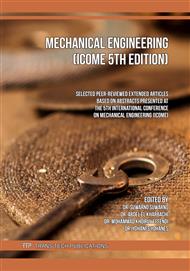[1]
K. Imado, A. Miura, M. Nagatoshi, H. Miyagawa and H. Higaki, H., A Study of Coefficient of Friction of UHMWPE in Various Contact Conditions and Measurement of Contact Temperature, Transactions of the Japan Society of Mechanical Engineers, Part A 69 677 (2003), 121–127.
DOI: 10.1299/kikaia.69.121
Google Scholar
[2]
V.N. Malyshev, Tribological aspects in friction stir welding and processing, in M.K.B. Givi, and P. Asadi (Eds), Advances in Friction-Stir Welding and Processing, Woodhead Publishing, (2014).
DOI: 10.1533/9780857094551.329
Google Scholar
[3]
O. Kahyaoglu, H. Unal, Friction and wear behaviours of medical grade UHMWPE at dry and lubricated conditions, International Journal of Physical Sciences 7 16 (2012), 2478–2485.
Google Scholar
[4]
N. Martinelli, S. Baretta, J. Pagano, A. Bianchi, T. Villa, G. Casaroli and F. Galbusera, Contact stresses, pressure and area in a fixed-bearing total ankle replacement: a finite element analysis, BMC musculoskeletal disorders, BioMed. Central 18 (2017), 493–493.
DOI: 10.1186/s12891-017-1848-y
Google Scholar
[5]
A.P.B. Saad, A. Syahrom, M.N. Harun and M.R.A. Kadir, Wear Prediction on Total Ankle Replacement Effect of Design Parameters, Springer, (2016).
DOI: 10.1007/978-3-319-21723-9_3
Google Scholar
[6]
B.J. Elliot, D. Gundapaneni and T. Goswami, Finite element analysis of stress and wear characterization in total ankle replacements, J. Mech. Behav. Biomed. Mater. 34 (2014), 134–145.
DOI: 10.1016/j.jmbbm.2014.01.020
Google Scholar
[7]
S.C. Tadepalli, A. Erdemir and P.R. Cavanagh, A Comparison of the Performance of Hexahedral and Tetrahedral Elements in Finite Element Models of the Foot, ASME 2010 Summer Bioeng. Conf. (2010).
DOI: 10.1115/sbc2010-19427
Google Scholar
[8]
S.C. Tadepalli, A. Erdemir and P.R. Cavanagh, Comparison of hexahedral and tetrahedral elements in finite element analysis of the foot and footwear, J. Biomechanics 44 12 (2011), 2337–2343.
DOI: 10.1016/j.jbiomech.2011.05.006
Google Scholar
[9]
D. Gundapaneni, J.T. Tsatalis, R.T. Laughlin and T. Goswami, Wear characteristics of WSU total ankle replacement devices under shear and torsion loads, J. Mech. Behav. Biomed. Mater. 44 (2015), 202–223.
DOI: 10.1016/j.jmbbm.2014.12.010
Google Scholar
[10]
S.M. Scott, M.L. Linden, J.E. Hooper, P. Cowan and T.H. Mercer, Quantification of gait kinematics and walking ability of people with multiple sclerosis who are new users of functional electrical stimulation, J. rehabilitation medicine 45 (2013), 364–369.
DOI: 10.2340/16501977-1109
Google Scholar
[11]
D.M. Tetreault and F.E., Kennedy, Friction and wear behavior of ultrahigh molecular weight polyethylene on Co-Cr and titanium alloys in dry and lubricated environments, Wear 133 (1989), 295–307.
DOI: 10.1016/0043-1648(89)90043-4
Google Scholar
[12]
M. Guezmil, W. Bensalah and S. Mezlini, Tribological behavior of UHMWPE against TiAl6V4 and CoCr28Mo alloys under dry and lubricated conditions, J. Mech. Behav. Biomed. Mater. 63 (2016), 375–385.
DOI: 10.1016/j.jmbbm.2016.07.002
Google Scholar
[13]
D. Nečas, Y. Sawae, T. Fujisawa, K. Nakashima, T. Morita, T. Yamaguchi, M. Vrbka, I. Křupka, and M. Hartl, The Influence of Proteins and Speed on Friction and Adsorption of Metal/UHMWPE Contact Pair, Biotribology 11 (2017), 51–59.
DOI: 10.1016/j.biotri.2017.03.003
Google Scholar
[14]
A. Wang, D.C. Sun, S.-S. Yau, B. Edwards, M. Sokol, A. Essner, V.K. Polineni, C. Stark, and J.H. Dumbleton, Orientation softening in the deformation and wear of ultra-high molecular weight polyethylene, Wear 203–204 (1997), 230–241.
DOI: 10.1016/s0043-1648(96)07362-0
Google Scholar
[15]
R. Lee, L. Korduba and A. Wang, An improved theoretical model of orientation softening and cross-shear wear of ultra high molecular weight polyethylene, Wear 271 (2011), 2230–2233.
DOI: 10.1016/j.wear.2010.12.054
Google Scholar
[16]
V. Saikko, Effect of contact pressure on wear and friction of ultra-high molecular weight polyethylene in multidirectional sliding, Proc. Inst. Mech. Eng., Part H: J. Eng. in Medicine 220 (2006), 723–731.
DOI: 10.1243/09544119jeim146
Google Scholar
[17]
N. Martinelli, S. Baretta, J. Pagano, A. Bianchi, T. Villa, G. Casaroli and F. Galbusera, Contact stresses, pressure and area in a fixed-bearing total ankle replacement: a finite element analysis, BMC Musculoskelet Disord 18 (2017), 493.
DOI: 10.1186/s12891-017-1848-y
Google Scholar
[18]
S.V. Panin, D.G. Buslovich, L.A. Kornienko, Y.V. Dontsov, V.O. Alexenko and B.B. Ovechkin, Comparison of Structure and Tribotechnical Properties of Extrudable UHMWPE Composites Fabricated by HIP and FDM Techniques, AIP Conf. Proc. 2051 (2018), 020229-1–020229-5.
DOI: 10.1063/1.5083472
Google Scholar
[19]
I. Khosravipour, Contact stress analysis of Surface guided knee implant using finite element modeling, Thesis, University of Manitoba, (2015).
Google Scholar
[20]
M.T. Makola, and T. Goswami, Hip implant stem interfacial motion, a finite element analysis. International Journal on Experimental and Computational Biomechanics 1 4 (2011), 343–358.
DOI: 10.1504/ijecb.2011.039946
Google Scholar
[21]
B. Elliott and T. Goswami, Implant material properties and their role in micromotion and failure in total hip arthroplasty, Int. J. Mech. Mater. Des. 8 1 (2012), 1–7.
DOI: 10.1007/s10999-011-9172-4
Google Scholar



